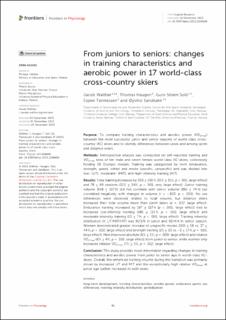| dc.description.abstract | Purpose: To compare training characteristics and aerobic power (VO2max) between the most successful junior and senior seasons of world-class cross-country (XC) skiers and to identify differences between sexes and among sprint and distance skiers.
Methods: Retrospective analysis was conducted on self-reported training and VO2max tests of ten male and seven female world-class XC-skiers, collectively holding 38 Olympic medals. Training was categorized by form (endurance, strength, speed, other) and mode (specific, unspecific) and was divided into low- (LIT), moderate- (MIT), and high-intensity training (HIT).
Results: Total training increased by 203 ± 130 h (35% ± 31%, p < .001, large effect) and 78 ± 69 sessions (21% ± 24%, p < .001, very large effect). Junior training volume (658 ± 107 h) did not correlate with senior volume (861 ± 74 h) but correlated negatively with changes in volume (r = −.822, p < .001). No sex differences were observed related to total volume, but distance skiers increased their total volume more than sprint skiers (p = .037, large effect). Endurance training increased by 197 ± 117 h (p < .001; large effect) tied to increased low-intensity training (186 ± 115 h, p < .001; large effect) and moderate-intensity training (13 ± 7 h, p < .001; large effect). Training intensity distribution (% LIT/MIT/HIT) was 91/3/6 in junior and 92/4/4 in senior season. Women demonstrated greater increase of unspecific modes (100 ± 58 vs. 37 ± 44 h, p = .022; large effect) and strength training (25 ± 23 vs. −3 ± 17 h, p = .010, large effect). Men improved absolute (8% ± 5%; p = .009; large effect) and relative VO2max (6% ± 4%; p = .016; large effect) from junior to senior, while women only increased relative VO2max (7% ± 5%, p = .012; large effect).
Conclusion: This study provides novel information regarding changes in training characteristics and aerobic power from junior to senior age in world-class XC-skiers. Overall, the enhanced training volume during this transition was primarily driven by increased LIT and MIT and the exceptionally high relative VO2max at junior age further increased in both sexes. | en_US |

